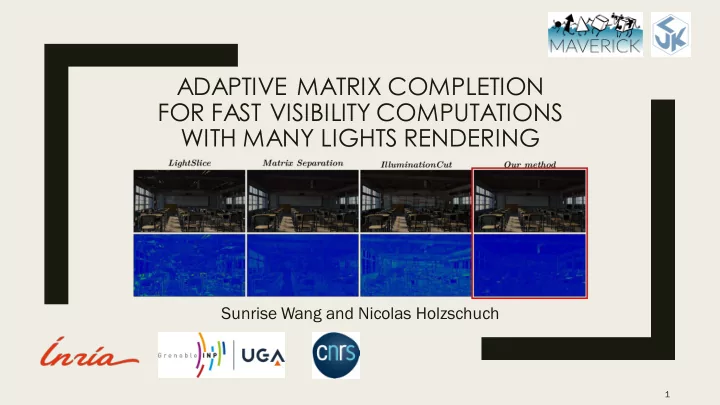

ADAPTIVE MATRIX COMPLETION FOR FAST VISIBILITY COMPUTATIONS WITH MANY LIGHTS RENDERING Sunrise Wang and Nicolas Holzschuch 1
Many-Lights Problem ■ Direct lighting problem ■ Large numbers of point lights – Instant Radiosity (Keller '97) ■ VPLs approximate indirect lighting ■ Can range from thousands to millions of lights – Expensive – Accurate visibility needs ray-casting 2
Contributions ■ Fast Many-Lights framework – Clustering – Visibility Approximation ■ Adaptive matrix completion to approximate visibility ■ Improvements to Adaptive Matrix Completion for boolean visibility 3
Scalable Many-Lights Methods ■ Hierarchical clustering (Walter et al. '05, Walter et al. '06, Walter et al. '12, Bus et al. '15.) – Hierarchically clusters the VPLs – Traverses tree to extract clusters ■ Matrix-based methods (Hasan et al. '07, Ou & Pellacini '11) – Formulates problem as matrix – Clusters VPLs with information from sampling matrix 4
Many-Lights Matrix Lights R e c e i v e r s ■ Lights as columns, receiving points as rows ■ Final colour of receiver = sum of values in row 5
Many-Lights Matrix ■ Approximately low-rank – Most information lies within few basis columns ■ Some existing work – Generalized Nystrom method for inverse rendering (Wang et al. '09) – Low-rank and sparse matrix recovery on Many-Lights Matrix (Huo et al. '15) – Matrix completion on participating media Many-Lights Matrix (Huo et al. '16) 6
Low-rank Matrix Completion Matrix Completion ■ Complete matrix from partially observed coefficients ■ Many or infinite solutions, recover lowest rank 7
Low-rank Matrix Completion ■ Matrix Completion Algorithms – Nuclear-norm minimization (Candes & Recht '09, Cai & Candes '10) – Alternating Least Squares (Haldar & Hernando '09, Wen et al. '12, Tanner & Wei '16) – Low-rank approximation (Goreinovet al. '97, Krishnamurthy& Singh '14) ■ Factors that influence required initial observations – Rank (number of linearly independent dimensions) – Coherence (localization of features) 8
Naive Matrix Completion of the Many- Lights Matrix ■ Limited to matrices with lower rank – Diffuse scenes with relatively simple occlusion – Participating media ■ Difficult to determine rank and coherence for arbitrary scenes ■ Materials and geometry influence rank and coherence – Glossier scenes & complex visibility = higher rank and coherence 9
Completing visibility ■ Can separate the many- lights matrix as M = S • V – S is shading matrix without visibility – V is a boolean visibility matrix – • is element -wise multiplication ■ Advantages – Shading easy to hardware accelerate – Fewer factors impacting rank and coherence of V – Allows for improvements to matrix completion algorithm 10
Our framework Generate VPLs Generate Slice Receivers Combine Slices Receivers For each h slice Cluster VPLs Shade without Generate final slice Complete visibility visibility image Our contri ribution on 11
Adaptive Matrix Completion (Krishnamurty A. & Singh A. '14) [7] ■ Iteratively completes sub-sampled columns – Using basis – If can't, full sample & expand basis ■ Advantages – Relaxes row space coherence constrants – Operates on smaller basis -> faster 12
Adaptive Matrix Completion for Boolean visibility ■ Blue = low rank, red = high rank, green = high coherence ■ Low-rank areas have near identical columns 13
Adaptive Matrix Completion for Boolean visibility ■ Can approximate columnusing a single basis vector – Replace pseudo-inverse with matching Compared against pseudo-inverse of Q over ℝ and Gauss-Jordan elimination – O(mn) rather than O(mn 2 ) ■ of matrix over GF(2) 14
Adaptive Matrix Completion for Boolean visibility 15
Adaptive Matrix Completion for Boolean visibility 16
Importance sampling ■ More samples where visibility changes ■ Use information from previous columns ■ Maintain discrete distribution d – Update d when column fully sampled 17
Results ■ Over 12 scenes of varying complexity – VPLs in more diffuse scenes, VSLs in glossier scenes ■ Ground truth obtained by brute force ■ Compared to Low-rank and sparse separation (Huo et al. '15) , IlluminationCut (Bus et al. '15) , Lightslice (Ou & Pellacini '11) , and our framework without matrix completion – only LightSlice and our method without matrix completion in VSL scenes 18
Results – Bathroom (185s, 23% samples) 19
Results – San Miguel (125s, 16.64% samples) 20
Results – Sponza (140s, 11.81%) 21
Results – San Miguel -L1 equal time error images of Low rank and sparse recovery (Huo et al. '15) (first) versus our method (second) 1 0 22
Visibility matrix rank ■ Rank is higher in penumbra – Receivers visibile varies slightly per light ■ Compared to Many-Lights matrix – Rank higher in diffuse scenes – Lower in glossier scenes 23
Drawbacks ■ Inefficient column sampling 24
Drawbacks ■ Clustering method does not consider visibility 25
Conclusions ■ Method for speeding up Many-Lights renders – clustering & visibility approximation ■ Approximates visibility with Adaptive Matrix Completion ■ Improve Adaptive Matrix Completion for visibility ■ Over 3 times faster for equal quality 26
Future Work ■ Address to drawbacks ■ Extend algorithm to area lights ■ Integrating over other domains? – Time, Spectrum, Lens etc. ■ Matrix completion in other contexts – Path-tracing, denoising etc. 27
Quest stions? s? 28
Adapting sample-rate ■ Slices have different ranks ■ Inefficient to use same sample-rate ■ Use verification samples to adapt 29
Recommend
More recommend